Drug regulatory authorities in various countries have established stringent limits on the residual nucleic acids in biological products. For example, the FDA mandates that the residual DNA in biologics derived from host cells should not exceed 100 pg per dose. At the same time, the European Pharmacopoeia requires that residual DNA in biologics be below 10 ng per dose. Therefore, it is essential to eliminate residual nucleic acids during production to meet these regulatory standards. SuperNuclease® offers several advantages over traditional nucleic acid removal methods.
SuperNuclease® is a highly effective endonuclease that has been genetically engineered to efficiently degrade nucleic acids. This powerful enzyme is nonspecific and highly active, capable of completely digesting RNA and DNA in various forms, including single-stranded, double-stranded, linear, circular, and supercoiled. It breaks down nucleic acids into oligonucleotides, typically consisting of 3–5 bases with 5′-monophosphate termini.
The SuperNuclease® and ELISA kit from Sino Biological are both efficient solutions for removing host cell nucleic acid impurities in manufacturing and bioprocessing workflows while minimizing the presence of residual nucleases.
SuperNuclease
Sino Biological provides both RUO-grade (Research Use Only) and GMP-grade (Good Manufacturing Practice) SuperNuclease® products for research and manufacturing applications. Its GMP-grade SuperNuclease® products are developed in compliance with ISO 13485 and the GMP system, making them ideal for use in gene and cell therapies, vaccines, and other biologics.
These enzymes offer exceptional efficiency, superior quality, and versatile applications. Additionally, the Drug Master File (DMF) for SuperNuclease® (DMF Number: 035978) has been filed with the FDA, facilitating regulatory submissions and approvals.
Product list
Source: Sino Biological Inc.
| Cat# |
Description |
Feature |
Concentration |
Specific activity |
Purity |
| SSNP01 |
SuperNuclease |
RUO-grade, Lyophilized powder |
—— |
≥1.1×106
U/mg |
> 95% by SDS-PAGE |
| GMP-SSNP01 |
GMP-grade SuperNuclease |
GMP-grade, Liquid |
≥1.0
mg/mL |
≥1.1×106
U/mg |
≥ 99% by SEC-HPLC |
| GMP-SSNP01-G |
GMP-grade SuperNuclease
(50% Glycerol) |
GMP-grade, 50% (v/v) Glycerol |
≥1.0
mg/mL |
≥1.1×106
U/mg |
≥ 99% by SEC-HPLC |
| GMP-SSNP01-AF |
GMP-grade SuperNuclease
(Animal-Free) |
GMP-grade, Animal-free, Liquid |
≥1.0
mg/mL |
≥1.1×106
U/mg |
≥ 99% by SEC-HPLC |
Product features
- Validated analytical techniques like activity, sterility, and SEC-HPLC
- High quality, high efficiency, and numerous applications
- Adherence to the specifications listed in drug applications (DMF filed)
- Bioequivalent to nuclease products sold in stores
- Has been employed by numerous biologics businesses
Applications
- Exogenous nucleic acids are eliminated from biological products
- Decrease in viscosity brought on by nucleic acids
- Removal of nucleic acids that have become entangled on the surface of particles (viruses, inclusion bodies, etc.), which helps the particles to be released and purified
- Preventing the clumping of cells
SuperNuclease under strict quality control standards
Source: Sino Biological Inc.
| Test |
Standard |
Method |
| Appearance |
Clear liquid, no visble particles |
Visual Inspection |
| Bottle label |
Neat and complete |
Visual Inspection |
| Sealability |
Sealed tight |
Visual Inspection |
| Protein quantification |
≥1 mg/mL |
UV (General Chapter 0401 of ChP 2020 Volume IV) |
| Purity |
≥95% |
SDS-PAGE (General Chapter 0541 of ChP 2020 Volume IV) |
| Purity |
≥99% |
SEC-HPLC (General Chapter 0512 of ChP 2020 Volume IV) |
| Specific activity |
≥ 1.1×106 U/mg |
Salmon Sperm DNA Degradation Assay |
| Residual protease |
Not detectable |
Universal Substrate |
| Bacterial endotoxin |
≤10 EU/mg |
Gel-Clot (General Chapter 1143 of ChP 2020 Volume IV) |
| Mycoplasma |
Negative |
qPCR (General Chapter 3301 of ChP 2020 Volume IV) |
| Residual host cell protein |
≤0.5 μg/mg
(500 ppm) |
ELISA (General Chapter 3412 of ChP 2020 Volume IV) |
| Heavy metals |
≤10 ppm |
Colorimetry (General Chapter 0821 of ChP 2020 Volume IV) |
| Sterility test |
No growth |
Membrane Filtration (General Chapter 1101 of ChP 2020 Volume IV) |
| Human-derived virus |
Negative |
qPCR (General Chapter 3306 of ChP 2020 Volume IV) |
| Abnormal toxicity |
All alive and healthy |
Mouse Test (General Chapter 1141 of ChP 2020 Volume IV) |
Operating conditions
Sino Biological has extensively examined SuperNuclease's performance under various operating conditions, including temperature, pH, magnesium ion, buffer composition, salt concentration, and other variables. The test results shown below clearly show that SuperNuclease satisfies the necessary specifications and shows excellent stability.
SuperNuclease Appropriate Reaction Conditions. Source: Sino Biological Inc.
| Condition |
Optimal* |
Effective** |
| Mg2+ |
1-2 mM |
1-10 mM |
| pH |
8.0-9.5 |
5.5-9.5 |
| Temperature |
37℃ |
0-50℃ |
| DTT |
0-200 mM |
>200 mM |
| Monovalent cation concentration (Na+, etc.) |
0-100 mM |
0-400 mM |
| PO43- |
0 mM |
0-50 mM |
| Tween20 |
0-0.8% |
0.80% |
| Brij35 |
0-0.8% |
>0.8% |
*“Optimal” is defined as the condition under which SuperNuclease retains ≥90% of its activity.
**“Effective” is defined as the condition under which SuperNuclease retains >15% of its activity.
Typical SuperNuclease applications
Reducing viscosity in cell lysates
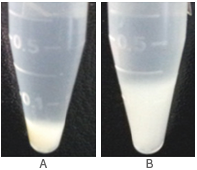
Viscosity reduction assay shows that SuperNuclease reduces the viscosity of E. coil lysate. A. In the presence of 25U/mL SuperNuclease. B. In the absence of SuperNuclease. Image Credit: Sino Biological US Inc.
Digesting various types of nucleic acids
The rate of degradation is on par with competing products.
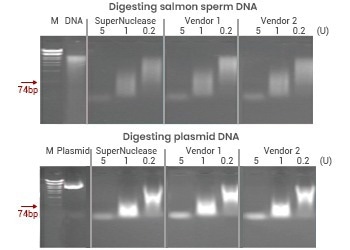
Image Credit: Sino Biological US Inc.
Removing residual host cell DNA from lentiviral supernatant
- In the lentiviral supernatant, the initial amount of residual host cell DNA was 803.58 ng/mL.
- The amount of remaining host cell DNA was significantly reduced by nuclease treatment of the lentiviral supernatant.
- qPCR was used to quantify the DNA of residual host cells.
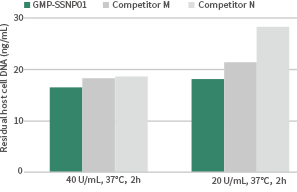
Image Credit: Sino Biological US Inc.
Salt Active SuperNuclease
SuperNuclease is typically used to extract host nucleic acids from biological products; however, in the preparation and purification of some biological products, like those used in gene and cell therapy, it tends to lose activity under high concentrations of salt. Therefore, the best way to handle this problem is to use nucleases that are extremely active in situations with high salt concentrations.
Sino Biological has independently developed a Salt-Active Supernuclease (Cat#: SASN) based on its platforms for enzyme screening and engineering technology. This nuclease, which comes from halophilic microorganisms, is highly active at a range of high salt concentrations (200–600 mM), which makes it perfect for eliminating leftover host nucleic acids from the majority of bioproducts in medium—and high-salinity environments.
Product advantages
- Higher activity at high salt concentrations than traditional nucleases
- High stability: unaffected enzyme activity after storage at 25 °C for three months
- Easily removed from AAV and other viral vectors
Product validation data
Higher salt tolerance
Salt Active SuperNuclease retained high activity under high salt concentration conditions, while SuperNuclease lost its activity.
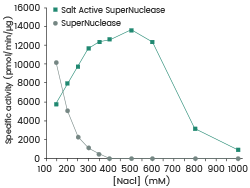
Specific activity of Salt Active SuperNuclease and SuperNuclease at different salt concentrations. Image Credit: Sino Biological US Inc.
High stability
After three months of storage at 25 °C, enzyme activity remained unchanged, according to real-time stability data.
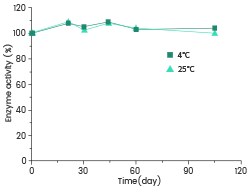
Activity of Salt Active SuperNuclease at 4 °C and 25 °C. Image Credit: Sino Biological US Inc.
Outstanding activity compared with competitors
The specific activity outperformed competitors.
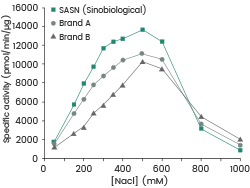
Specific activity of different salt-tolerant nucleases Test conditions: 20 mM Tris-HCl, 37 °C, pH 8.5. Image Credit: Sino Biological US Inc.
The ability to remove host DNA is superior to that of other brands
At high salt concentrations, like 300 and 500 mM, Salt Active SuperNuclease was more successful in removing DNA than the competitor.
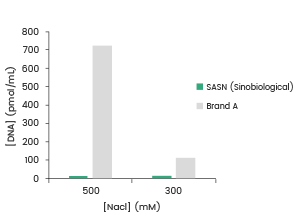
DNA removal effect of different salt-tolerant nucleases on CHO cells. Test conditions: 1.0 × 107 cells/mL CHO cell lysate, 375 pg enzyme, 1 hour, host residual DNA detection performed according to the Chinese Pharmacopoeia. Image Credit: Sino Biological US Inc.
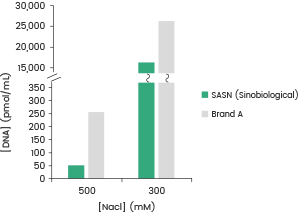
DNA removal effect of different salt-tolerant nucleases on 293 cells. Test conditions: 2.5×107 cells/mL 293 cell lysate, 38 pg enzyme, 0.5 hours, host residual DNA measured using a commercial host residual DNA detection kit. Image Credit: Sino Biological US Inc.
SuperNuclease ELISA Kit
To ensure that biological products fulfill production standards, residual nucleases should be quantitatively detected after nucleases have effectively removed nucleic acids. Sino Biological provides a SuperNuclease ELISA Kit (Cat #: KIT-SSNP01) to detect and quantify SuperNuclease and other major nucleases available in the market.
The kit was designed to quantitatively detect the amount of residual nuclease in various biological products' intermediates, semi-finished products, and finished products. In addition to having a high recovery rate of 80–120 %, a broad detection range of 46.87 to 3000 pg/mL, and high sensitivity, the SuperNuclease ELISA Kit also has a low detection limit of 14.55 pg/mL.
The kit has the following advantages
- Broad compatibility for identifying nucleases from various brands
- High specificity, using monoclonal antibodies for both detection and capture
- Time-saving and simple to use
- Good consistency from batch to batch
Product advantages
Stable and reliable quality
Stability
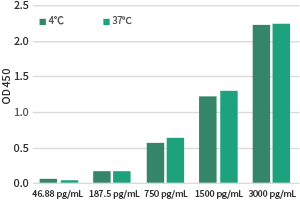
The concentration of the SuperNuclease. Image Credit: Sino Biological US Inc.
Accuracy
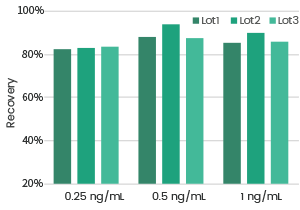
The concentration of the SuperNuclease. Image Credit: Sino Biological US Inc.
Specificity
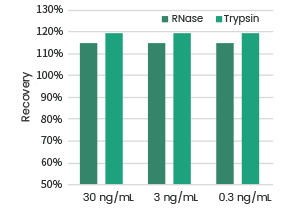
The concentration of the interference. Image Credit: Sino Biological US Inc.
High sensitivity
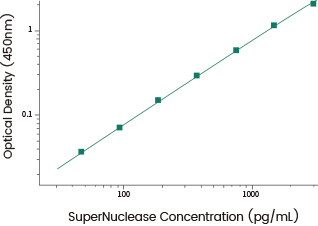
Super Nuclease Concentration (pg/mL). Image Credit: Sino Biological US Inc.
Good versatility
The accuracy of the SuperNuclease ELISA Kit is comparable to other brands.
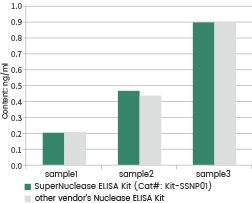
Detection of residual SuperNuclease. Image Credit: Sino Biological US Inc.
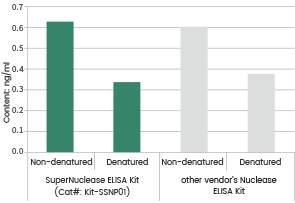
Detection of the content of non-denatured and denatured nuclease from another brand. Image Credit: Sino Biological US Inc.
Learn more about Sino's reagents here!